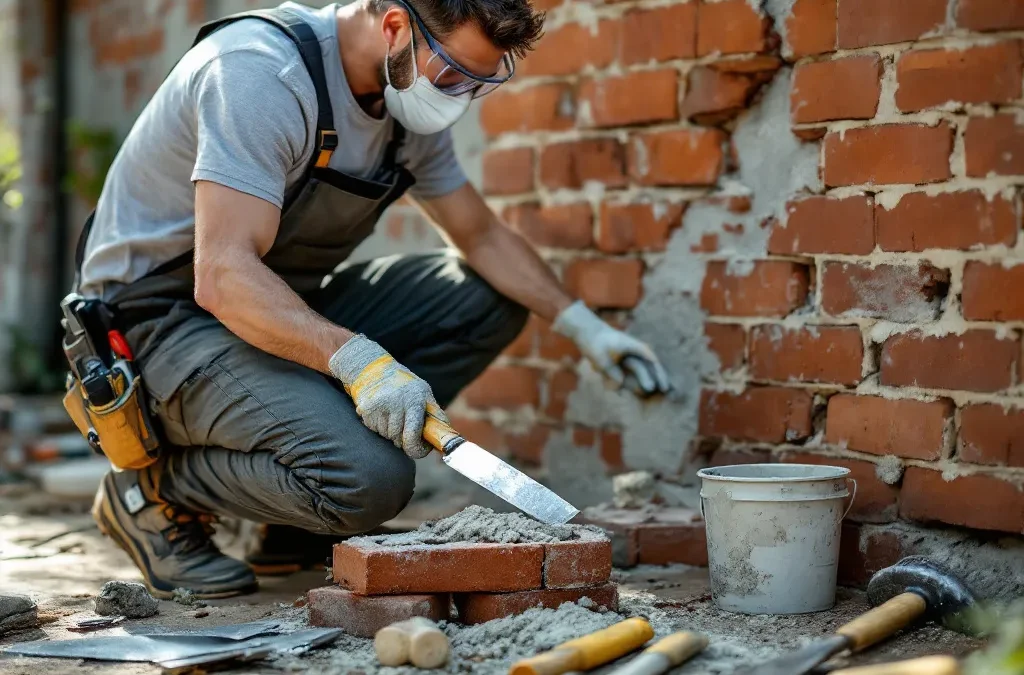I. Introduction
Brick maintenance and repair are essential tasks for homeowners aiming to preserve their property’s structural integrity and aesthetic appeal. Over time, bricks can suffer from wear and tear, leading to common issues such as cracks, loosening, and spalling. Identifying these problems early and addressing them with the right tools can save homeowners both time and money in the long run.
II. Essential Brick Repair Tools
A. Masonry Trowel
A masonry trowel is a fundamental tool for any brick repair project. It features a flat blade that allows for the smooth application of mortar, essential for laying bricks and filling joints. There are two main types of masonry trowels: pointed trowels, which are useful for precision work, and flat trowels, best suited for spreading mortar evenly.
B. Brick Hammer
A brick hammer plays a crucial role in brick repair, especially when it comes to breaking or chiseling bricks to fit specific spaces. This tool typically features a flat striking face on one side and a chisel-like blade on the other, allowing for versatility in handling various tasks. When choosing a brick hammer, look for one with a comfortable grip and adequate weight to aid in efficient chiseling without over-exertion.
C. Pointing Trowel
The pointing trowel is specifically designed for fine mortar application in narrow joints between bricks. Its smaller size and pointed tip make it ideal for reaching tight spots and ensuring a precise finish. Consider the size and material of the pointing trowel when selecting one for your repairs, as stainless steel options offer durability and resist rusting.
III. Mortar and Mixing Equipment
A. Mortar Mixer
Having a mortar mixer is vital for achieving a uniform mix essential for brick repairs. Consistency in mortar can significantly impact the success of your repair work, preventing issues such as cracking or inconsistent adherence. Homeowners can choose between portable mixers for larger jobs and bucket mixers for smaller repairs, depending on the project’s scale.
B. Mixing Trowel
For mixing small amounts of mortar, a mixing trowel is an invaluable tool. This handheld device allows for effective mixing without the need for larger equipment, making it ideal for minor repairs. Look for a mixing trowel with a comfortable handle and appropriate dimensions to facilitate efficient blending of mortar.
IV. Safety Gear
A. Safety Goggles
Safety goggles are a must when performing brick repairs to shield your eyes from debris and dust. Protecting your vision is paramount, especially when chiseling or mixing materials that can create flying particles. Ensure that the goggles fit well and provide a secure seal to maximize protection.
B. Dust Mask
Using a dust mask during brick repairs is important for preventing respiratory issues caused by inhaling fine particles. Brickwork can generate a significant amount of dust, particularly during chiseling or grinding. Opt for a mask with a particulate filter to ensure you breathe clean air while working.
C. Work Gloves
Investing in suitable work gloves is essential for protecting your hands during brick repair tasks. Look for gloves made from durable materials that offer a good grip to handle bricks easily. Different glove types are available, from heavy-duty options for rough work to more flexible styles for greater dexterity.
V. Additional Tools for Specific Repairs
A. Chisel and Mason’s Hammer
A chisel paired with a mason’s hammer is essential for shaping and fitting bricks during repairs. The chisel allows for detailed work, enabling you to craft bricks to fit snugly in place, while the mason’s hammer delivers the force needed to drive the chisel effectively. Together, these tools facilitate precise adjustments to ensure a tight and clean fit.
B. Joint Raker
A joint raker is specifically designed for removing old mortar from between bricks, preparing the surface for new application. This tool allows for precise removal without damaging the bricks themselves, which is crucial for maintaining the integrity of your wall. Make sure to choose a joint raker that matches the width of the mortar joints in your brickwork.
C. Caulking Gun
A caulking gun is invaluable for sealing gaps and cracks after brick repairs are completed. Utilizing caulk can help to prevent moisture penetration and improve the durability of your masonry. Look for a caulking gun that’s comfortable to hold and easy to operate, allowing for smooth and even application.
VI. Optional but Helpful Tools
A. Level
Using a level helps ensure that bricks are laid evenly and securely, minimizing the risk of uneven settling over time. A properly leveled brick wall will not only look better but also enhance the wall’s structural integrity. For more info on construction best practices, check our guide on pre-pour checklists for concrete jobs.
B. Measuring Tape
Accurate measurements are crucial in brick repairs to ensure that you cut and fit bricks correctly. A measuring tape will help you gauge the size of bricks and the spacing between them accurately. For best results, choose a tape with clear markings and a sturdy construction that can withstand wear.
C. Wire Brush
A wire brush is useful for cleaning bricks before applying mortar, ensuring that surfaces are free of dust and debris. This cleaning step is vital for achieving a strong bond between the bricks and the mortar. Look for a wire brush with sturdy bristles that can effectively remove grime without damaging the brick.
D. Utility Knife
A utility knife serves various cutting needs during brick repair projects, such as cutting tarp or plastic sheeting. Its versatility makes it an essential addition to your repair toolkit. Choose a utility knife with a retractable blade for safety and ease of use.
VII. Maintenance Tips
Regular inspections of your brickwork for cracks and loose bricks are essential to prevent larger issues from developing. Keep an eye out for signs of wear and address them promptly with appropriate repairs. Additionally, mastering proper mortar mixing and application techniques will enhance the durability of your repairs, ensuring your brickwork remains strong for years to come.
VIII. Conclusion
Having the right tools for basic brick repairs is crucial in maintaining the longevity and appearance of your home. By investing in essential equipment like masonry trowels, brick hammers, and mixing devices, homeowners can successfully tackle minor repairs. With the right tools and a little effort, anyone can undertake brick repair projects with confidence.
Whether you’re preparing a surface or sealing joints, each step contributes to a better build. Learn from our expert articles such as Understanding Curing Times, Key Safety Measures, and Top Mistakes to Avoid to expand your knowledge and skill set.
If you’d like expert help or a quote for your brick repair needs, don’t hesitate—reach out today at 916-562-2345 to speak with our professionals.


